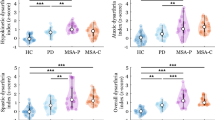Abstract
Patterns of dysarthria in spinocerebellar ataxias (SCAs) and their discriminative features still remain elusive. Here we aimed to compare dysarthria profiles of patients with (SCA3 and SCA6 vs. Friedreich ataxia (FRDA), focussing on three particularly vulnerable speech parameters (speaking rate, prosodic modulation, and intelligibility) in ataxic dysarthria as well as on a specific oral non-speech variable of ataxic impairment, i.e., the irregularity of oral motor diadochokinesis (DDK). 30 Patients with SCA3, SCA6, and FRDA, matched for group size (n = 10 each), disease severity, and disease duration produced various speech samples and DDK tasks. A discriminant analysis was used to differentiate speech and non-speech parameters between groups. Regularity of DDK was specifically impaired in SCA3, whereas impairments of speech parameters, i.e., rate and modulation were stronger affected in SCA6. Speech parameters are particularly vulnerable in SCA6, while non-speech oral motor features are notably impaired in SCA3.


Similar content being viewed by others
Abbreviations
- SCA:
-
Spinocerebellar ataxia
- FRDA:
-
Friedreich ataxia
- DDK:
-
(oral) Diadochokinesis
- BoDyS:
-
Bogenhausen Dysarthria Scales
References
Schöls L, Bauer P, Schmidt T, Schulte T, Riess O (2004) Autosomal dominant cerebellar ataxias: clinical features, genetics, and pathogenesis. Lancet Neurol 3:291–304
Dürr A (2010) Autosomal dominant cerebellar ataxias: polyglutamine expansions and beyond. Lancet Neurol 9:885–894
Jacobi H, Bauer P, Giunti P (2011) The natural history of spinocerebellar ataxia type 1, 2, 3, and 6. A 2-year follow-up study. Neurology 77:1035–1041
Taroni F, DiDonato S (2004) Pathways to motor incoordination: the inherited ataxias. Nat Rev Neurosci 5:641–655
Schulz JB, Borkert J, Wolf S et al (2010) Visualization, quantification and correlation of brain atrophy with clinical symptoms in spinocerebellar ataxia types 1, 3 and 6. Neuroimage 49:158–168
Seidel K, Siswanto S, Brunt ERP, den Dunnen W, Korf H-W, Rüb U (2012) Brain pathology of spinocerebellar ataxias. Acta Neuropathol 124:1–21
Rüb U, Schöls L, Paulson H et al (2013) Clinical features, neurogenetics and neuropathology of the polyglutamine spinocerebellar ataxias type 1, 2, 3, 6 and 7. Prog Neurobiol 104:38–66
Duffy JR (2005) Motor speech disorders. Substrates, differential diagnosis, and management, 2nd edn. Elsevier, St. Louis
Schalling E, Hartelius L (2004) Acoustic analysis of speech tasks performed by three individuals with spinocerebellar ataxia (SCA). Folia Phoniatr Logop 56:367–380
Schalling E, Hammarberg B, Hartelius L (2007) Perceptual and acoustic analysis of speech in individuals with spinocerebellar ataxia (SCA). Logop Phoniatr Voco 32:31–46
Schalling E, Hartelius L (2013) Speech in spinocerebellar ataxia. Brain Lang 127:317–322
Sidtis SS, Ahn JS, Gomez C, Sidtis D (2011) Speech characteristics associated with three genotypes of ataxia. J Commun Disord 44:478–492
Brendel B, Ackermann H, Berg D, Lindig T, Schölderle T, Schöls L, Synofzik M, Ziegler W (2013) Friedreich ataxia: dysarthria profile and clinical data. Cerebellum 12:475–484
Schmitz-Hübsch T, du Montcel ST, Baliko L et al (2006) Scale for the assessment and rating of ataxia: development of a new clinical scale. Neurology 66:1717–1720
Bürk K, Mälzig U, Wolf S et al (2009) Comparison of three clinical rating scales in Friedreich’s ataxia (FRDA). Mov Disord 24:1779–1784
Schulz JB, Boesch S, Bürk K et al (2009) Diagnosis and treatment of Friedreich ataxia: a European perspective. Nat Rev Neurol 5:222–234
Ziegler W, Zierdt A (2008) Telediagnostic assessment of intelligibility in dysarthria: a pilot investigation of MVP-Online. J Commun Dis 41:553–577
Nicola F, Ziegler W, Vogel M (2004) The Bogenhausener Dysarthria Scales (BODYS): an instrument for clinical diagnostic of dysarthria [German]. Forum Logopädie 18:14–22
Schmitz-Hübsch T, Eckert O, Schlegel U, Klockgether T, Skodda S (2011) Instability of syllable repetition in patients with spinocerebellar ataxia and Parkinson’s disease. Mov Disord 27:316–319
Ziegler W, Wessel K (1996) Speech timing in ataxic disorders: sentence production and rapid repetitive articulation. Neurology 47:208–2014
Ishikawa K, Watanabe M, Yoshizawa K et al (1999) Clinical, neuropathological, and molecular study in two families with spinocerebellar ataxia type 6 (SCA6). J Neurol Neurosurg Psychiatry 67:86–89
Guenther FH, Satrajit SG, Tourville JA (2006) Neural modeling and imaging of the cortical interactions underlying syllable production. Brain Lang 96:280–301
Acknowledgments
We would like to express our appreciation to the participants of this study for their willingness to support this research. This study was funded by the German Research Foundation (Deutsche Forschungsgemeinschaft, DFG, AC55/6-3; ZI469/10-3).
Conflicts of interest
The authors declare that they have no financial or other conflicts of interest.
Ethical standards
All included participants provided informed written consent prior to their study inclusion. This study was approved by the the local ethics committee of the University of Tübingen and have therefore been performed in accordance with the ethical standards laid down in the 1964 Declaration of Helsinki.
Author information
Authors and Affiliations
Corresponding author
Rights and permissions
About this article
Cite this article
Brendel, B., Synofzik, M., Ackermann, H. et al. Comparing speech characteristics in spinocerebellar ataxias type 3 and type 6 with Friedreich ataxia. J Neurol 262, 21–26 (2015). https://doi.org/10.1007/s00415-014-7511-8
Received:
Revised:
Accepted:
Published:
Issue Date:
DOI: https://doi.org/10.1007/s00415-014-7511-8




